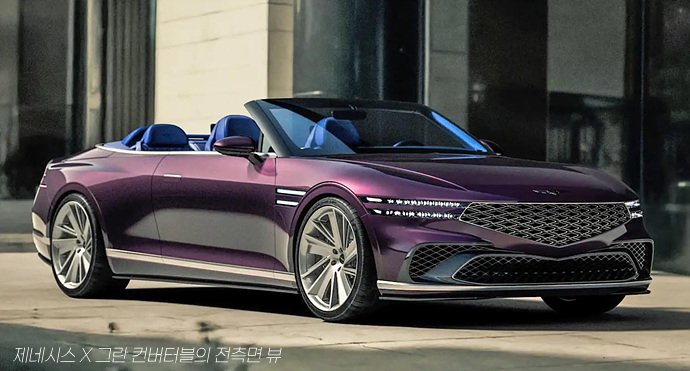
At this year’s Seoul Mobility Show, the Genesis brand unveiled the Genesis X Gran Coupe and Convertible. Genesis first introduced a convertible concept car in February 2023. This time, however, the Genesis Gran Coupe and Convertible appear closer to production models.

Reportedly, the Gran Coupe and Convertible are based on the flagship G90 of the Genesis brand. Previously, Genesis had released concept cars such as the X Coupe Concept and X Speedium Coupe Concept as large-bodied coupes, followed by the X Convertible Concept two years ago.

Generally, all global premium brands have two-door coupes and convertibles as a kind of symbolic presence. These models are considered essential for premium brands.

Although the demand for coupes and convertibles is extremely low in the Korean market, the same is true in other countries. Even though the market for two-door coupes and convertibles is small, these models serve as showcases for how unique and luxurious a brand can be. That is why they are often regarded as symbols of premium branding.

Until now, the Genesis brand has not had any production-model coupes or convertibles. It has only featured practical models such as four-door sedans and five-door SUVs, leaving something to be desired in terms of its global image as a luxury brand. However, starting a few years ago, Genesis began unveiling concept models of coupes and convertibles under the X series, and now the brand has unveiled a convertible with a more production-ready feel.

The Genesis X Gran Convertible has a retractable roof structure, though it was only displayed in the open position, so the material used for the roof when closed remains unclear.
Two years ago, the convertible concept was revealed as a hardtop convertible. That roof, which appeared to be made of metal, allowed for a sleek silhouette even when closed.
In contrast, convertible roofs made of fabric often reveal undulations in the surface due to the metal frame structures beneath. In some cases, the seams do not fully seal, leading to wind noise at high speeds.

However, hardtop convertibles do not solve all problems. The large roof structure is heavy, and the motorized mechanism to operate it is complex. The storage space needed for the large roof panel significantly limits trunk capacity, making it less practical.

In any case, the newly revealed Genesis X Gran Convertible was shown alongside the coupe, and the interior layout and finish give the impression of a near-production vehicle. It genuinely appears to be a coupe and convertible version of the G90.

The wheels and tires on the vehicle are sized 265R30/22. Even the Mercedes-Maybach sedan’s largest wheels provided by the manufacturer are 20 inches, with anything larger being a dealer option. If the Genesis Gran Coupe and Convertible are produced with standard 22-inch wheels, they may feature the largest base wheels on a production vehicle.
Of course, 22-inch tires with a 30 profile visually convey a strong and bold impression, but they do require some compromise in ride comfort.

Inside the Genesis X Gran Convertible, the instrument panel layout is very similar to the current G90. The rear seats are divided by a center tunnel, making the seating configuration 2+2.
The front seats appear to be integrated with the seatbelt system, and there are monitors installed for rear-seat passengers. The connection between the rear deck and the trunk lid is finished with smooth interior trim. This structure is nearly identical to the concept car unveiled two years ago.

The front-end design of the Genesis X Gran Coupe and Convertible is a slimmer reinterpretation of the G90 sedan. The concept car from two years ago featured daytime running lights reinterpreted from the shape of a radiator grille. However, the bumper design closely follows the form of the earlier concept. This is a design approach where the direction is first presented through a concept car, and then the production model inherits that design language.
Historically speaking, since the first automobiles were made from horse carriages, most cars up until the 1920s featured open-top convertible structures. With the advent of mass production, simpler steel roof structures became the norm to make cars more affordable.

Therefore, convertibles are less about economics or efficiency and more about highlighting luxury. In essence, they are luxury goods in the truest sense. Another characteristic of luxury goods is that their value is significantly influenced by the prestige of the brand. This, in turn, is also closely related to the international standing of the country to which the brand belongs. As such, only brands from advanced nations are generally recognized as producers of luxury products.
From that perspective, the recent rise in global recognition and evaluation of Hyundai and the Genesis brand may indeed be based on Hyundai’s improvements in quality and technological development. But at the same time, it likely also stems from the enhanced international status of South Korea today.
























